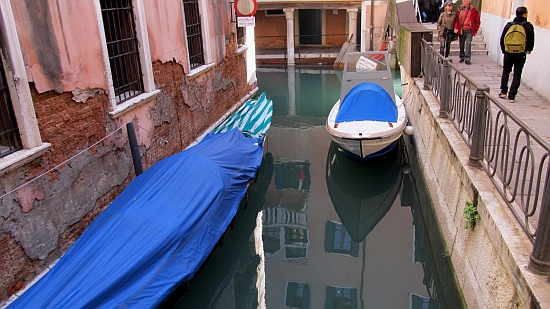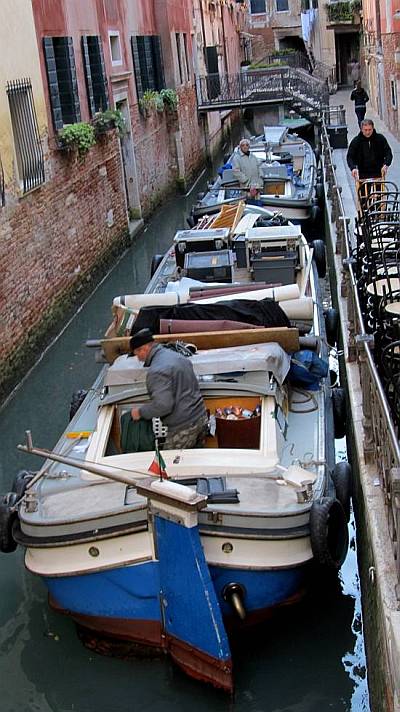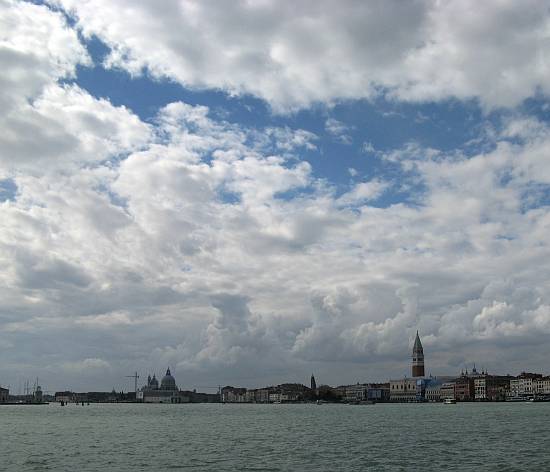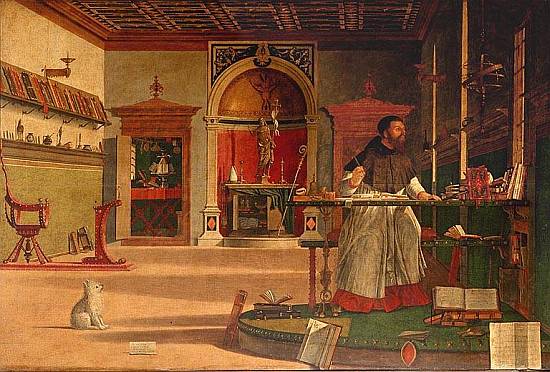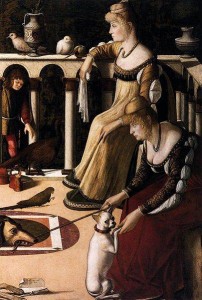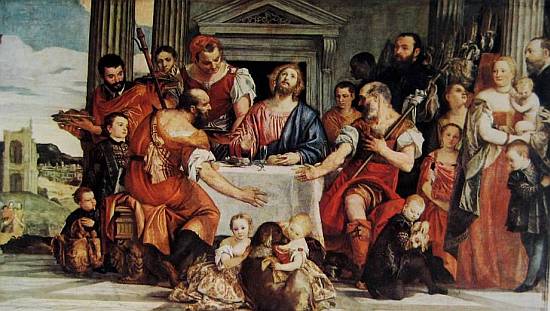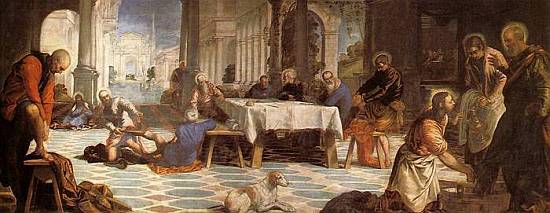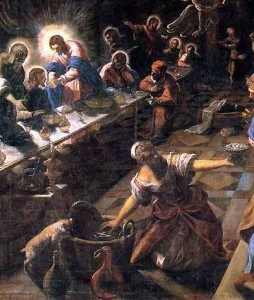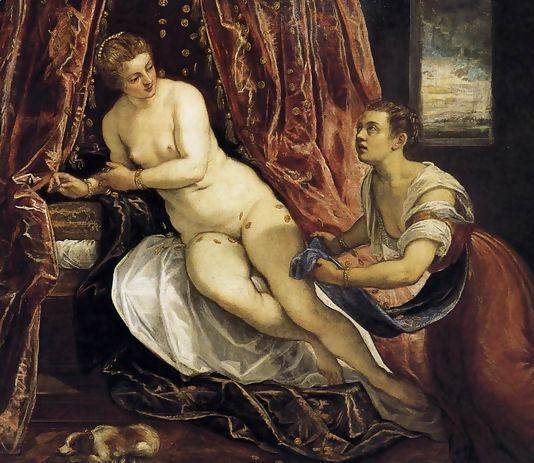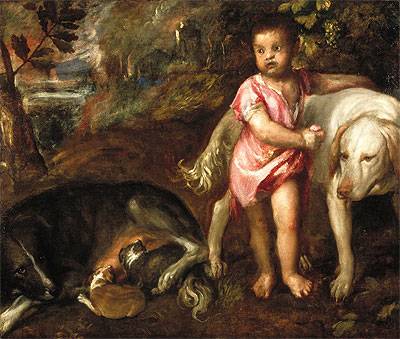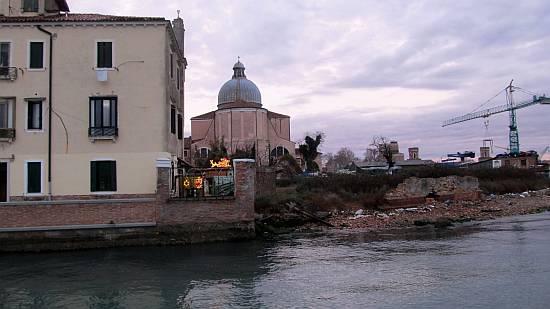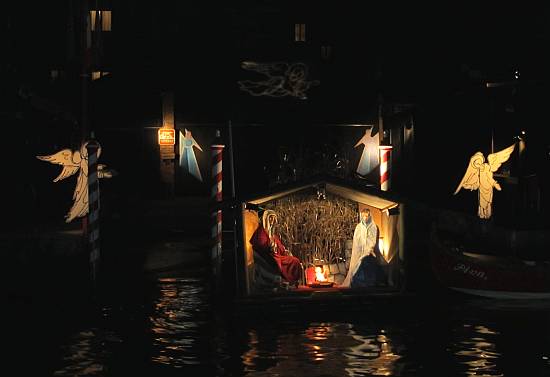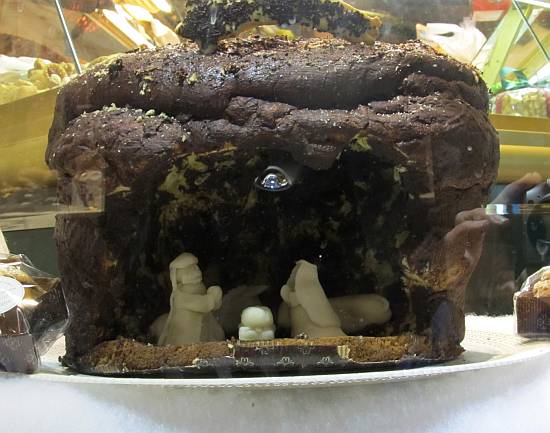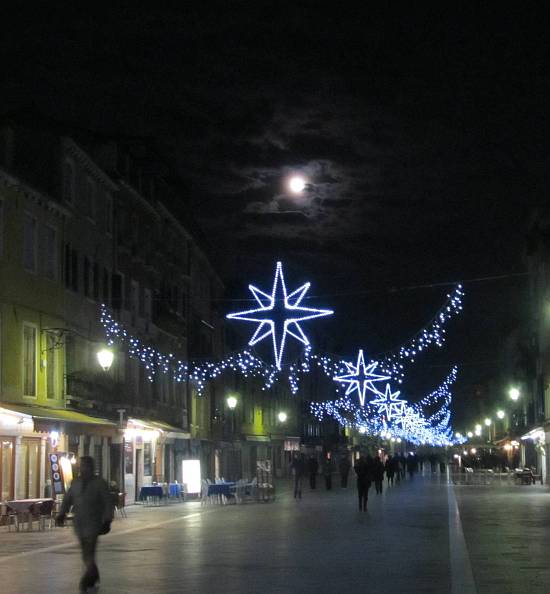
Some time ago I embarked on a series of what were going to be five posts, each dedicated to one of the classic senses, and how I indulge them here.
I haven’t yet shared my thoughts on the remaining two (sight and touch) and I’ll be putting that off for a little while longer.
What has pushed ahead of them in line are few non-traditional senses which have inordinate importance here. If you awaken these senses, the benefits ought to be many, such as helping to increase your enjoyment of Venice and, at the same time, minimize your impressive ability to spoil it for others.
By “you” I originally meant “tourists,” and much of what I’m going to say is, in fact, aimed at people who are just passing through. But I have to say that Venetians themselves can be astonishingly oblivious to the world around them. I just want you to know that I recognize that, in case anyone is tempted to retort “Well what about them?” Fine: They’re guilty too. But this is their city, and their country, too.
So today I present the sense of space. There isn’t much of it here. The city covers only about two square miles, and I estimate that 97 percent of that area is occupied by buildings or water. So you can see how tricky it’s going to be to fit everybody, particularly 20 million tourists or so, into a town not much bigger than New York’s 41st Precinct.
And it’s not useful to imagine there’s any difference between “public” and “personal” space. All the space here is personal. I mean public.
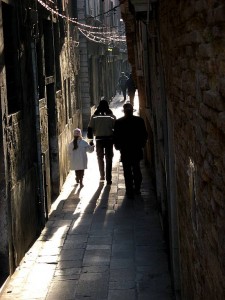
Venice has always been crowded — in fact, it was once almost three times more populous than it is now. But that didn’t particularly bother anyone, if the songs are to be believed.
There are many which praise some aspect of the city’s beauty or the beauty of life here. I’m not aware of a modern song praising Venice. (I do not regard “Ciao Venezia” as a song, even if it is transmitted by human vocal cords.) Maybe I should try to write one.
Anyway, one particular Venetian song (which naturally sounds better in Venetian) contains this refrain: “Long live this great immensity/only Venice is beautiful/only our city.”
“Great immensity”? Besides being redundant, it seems crazy. This is a city that’s all twisted up in lots of skinny little streets and random knotty open spaces swarming with people pushing children in strollers, dragging overloaded shopping trolleys, brandishing large open umbrellas, or merely groups standing stock still at the exact point where there is no room to get around them.
The “immensity” praised in the song about Venice refers, I believe, to its environment: the lagoon. Anyone who has ever gone out in a boat even a quarter mile from the city realizes that this extraordinary city is floating in the center of a vast amount of water and sky.
My experience, and — I deduce — that of countless Venetians who have come before, shows that the lagoon is not only the matrix of the city but the only known antidote to its compression.
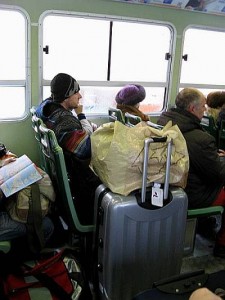
But even if your only chance to feel this spaciousness is from a vaporetto (which will be crowded….), I hope you will somehow feel the enchantment and, yes, immensity of the city’s surroundings.
In any case, you’ll have to go ashore eventually, which is where your sense of space is going to have to get to work. Because your awareness of where you are, and what you do there, is going to have a really important effect not only on how you feel about Venice, but how everybody around you — especially any Venetians, if you care — feels about it too.
I respectfully recall to your attention the fact that Venice, small as it may be, at its apex was both the home and the workplace of almost 200,000 residents, not to mention an uncounted number of visitors, here on either business or pleasure or even displeasure. Among other things, Venice was a major port for pilgrims headed from Europe to the Holy Land. They could have been here as long as a month, waiting to find a berth on a ship (no reservations, obviously). This was much longer than the average modern tourist’s visit, and there were periods in which there were 50 ships leaving in a single month, or roughly two a day. (Not made up.) Which adds up to a fairly crushing quantity of people.
Furthermore, if you think the city is crowded now, spare a thought for the old days, when everyone who had a choice lived as much of their lives outdoors as they could. Except for sleeping and eating, families (which were numerous) spent most of their day out in the courtyard or the street, or somewhere other than home, where there also was no space.
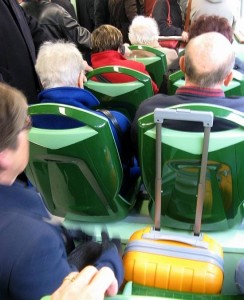
And then there was the cargo: Vast amounts of often really space-intensive items being offloaded and transported from A to B. Bricks. Blocks of marble. Lumber. Bales of wool. Imagine yourself walking down a street behind three people who are carrying enormous wicker backpacks loaded with coal. So it’s always been pretty cramped here.
Nevertheless, today we have all sorts of modern ideas about comfort and manners which make Venice demanding in an equally intense way.
Having said all that, I’d like to offer a few fundamental suggestions as to how to minimize the crampage. If you accept them, you have a chance at making life more pleasant for you and certainly for everyone around you. If you don’t really care — and there seems to be an abundance of visitors in this category — then you may fire when you are ready, Gridley.
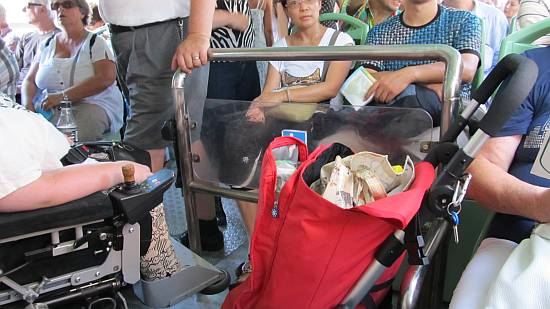
There are three situations in which you have no choice but to share space outdoors: Walking, standing, and sitting.
Walking: To keep everybody, including you, moving in even some semblance of progress, try to imagine that you’re driving your car. The same general rules apply here when you’re walking.
If you’re moving slowly, keep to the side. Do not make sudden stops. Do not make sudden turns. Do not stop in the middle of the street and just stand there. Check your rear-view mirror often, because it’s very likely somebody is coming up behind you intending to pass you. In which case, move aside and let them. You’d be astonished at how many people do not do any of those things.
Forget the car metaphor and keep in mind that you are living in three dimensions. Fingers: Tempting as it may be, try to avoid suddenly pointing at something, no matter how surprising or beautiful it is; for some reason, a person pointing is often indicating something dangerously close to eye level. Elbows: If you stand somewhere with your hands on your hips, you’ve just taken space away from the persons on your elbow side for no clearly necessary reason.
If somebody wants to get past you, they will most likely start with a polite “Permesso.” (Or “con permesso.”) Venetians may say this as many as three times; if there’s no reaction, they push. The international language. If it happens to you, there was a reason.
Standing: If there appear to be too many people, you can be sure there will be far too much of their stuff. If you need to stop to check your map or hold an unscheduled meeting of the family committee, make an effort to put your boxcar-load of baggage somewhere out of the way. Slalom races are fun if you’re aiming for a medal in the World Cup, but not for somebody trying to get somewhere that’s important to him, like his accountant or home to his kid who’s running a fever.
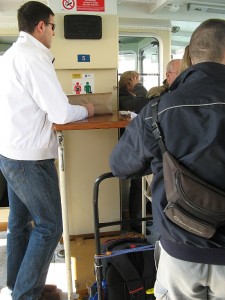
On the vaporetto, try to organize your bags in as little space as possible. A person (for example, me) shouldn’t have to explain that you could put your smaller bag on top of your larger bag, instead of next to it. I mean, when you think about it.
If you’re carrying anything larger than an empty messenger bag, handle it with the awareness that wherever you put it, it’s taking precious square inches away from somebody else. I know it’s really hard to haul all that baggage down cramped streets and over bridges and so on. I know that there is little or no space on the vaporettos for anything larger than you, and often not even that. But the fact that many people devote more attention and concern to their steamer trunks or Himalayan-expedition backpacks than they do to their fellow passengers is something that baffles, and can often irritate, any nearby Venetians, especially if they’re trying to get past you (see: “slalom,” above).
What to do?
First: Minimize the space you occupy. For example: Do not put your suitcases/duffel bags/backpacks on the seat next to you. Seem obvious? Apparently it isn’t. “Hey! Empty space! It’s mine!” Actually, it’s not!
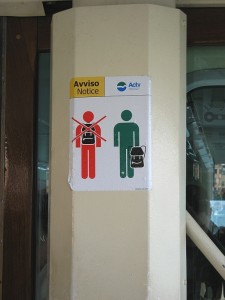
Second: Take off your backpack. They’ve even made it a rule on the vaporettos, but the simple sense of this little act continues to elude nine and a half out of every ten people. If it’s on your back, take it off. Even a daypack is a huge nuisance to everyone around you. You may think it’s part of you, but the only person who wouldn’t annoy their fellow passengers with something protruding from his or her spine would be the hunchback of Notre Dame. If you can take it off, do so immediately and put it at your feet. Or in a corner. Or maybe don’t even bring it. How far could it be to the next oasis?
Third: Get out of the way. Every day, oblivious people stand right where everybody else needs to pass. On the street, on the vaporetto, wherever. On the vaporetto dock — particularly, for some reason, at the Accademia stop — masses of eager people who want to get on fill the entire area needed for the arriving passengers to get off. If there is an explanation for this, it will have to come from the realm of astronomy, where matter retains all sorts of contradictory characteristics. Here, though, matter occupies space.
Then there are people who find a spot that works for them and just……you know…..stand there….as if nobody else existed. They block doorways, they block aisles. It’s not as if their kid is having an asthma attack and nothing else matters. They just stand there. Even the fact that you have to contort yourself to get past them doesn’t make any impression whatever. That’s where they are, just deal with it, Maude. I have never understood what attracts people to standing in the vaporetto doorway. Go out, or stay in. Why are you trying to do both? Are you not able to decide where you want to be?
Then there are all those time when you must force your way onto a vaporetto because it’s crammed with people in the open middle space where boarding and exiting takes place, while the interior of the boat is almost empty. I realize that visitors want to be outside where they can look around and take pictures. If you’re determined to stay outside, please do everything in your power not to block the only area available for getting on and off.
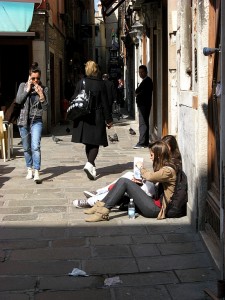
Sitting: People between the ages of 12 and 18 seem to have decided that the floor is their tribal territory. Sitting or sprawling in groups on the ground anywhere that appeals to them is not merely the best thing ever, it has become something like a right. I’ve seen teenagers literally lying on the ground where lots of people need to walk. One memorable pair of girls (American) was stretched out across the wooden dock in front of the ramp leading to the vaporetto dock. Hundreds of people needed to walk there. (See: “slalom,” above).
It all seems so obvious.
But wait! — I hear you cry — what about all those rude Venetians who do all those rude things (except for sitting on the ground), as if WE didn’t exist?
I know. I know they’re there, and I know they do those things, and they don’t have any more of a good excuse than anyone else.
I know theyalso position themselves in the exit area of the vaporetto dock so that they can get on the vaporetto first.
I know they somehow manage to slither past you to claim that minuscule empty spot in front of you. You might feel that they’re jumping a queue, but they don’t see a queue. I have finally concluded that a person who does this has decided that since you’re not occupying that space, that means you’ve relinquished it and it’s available to anybody who wants it. Now I actually do it myself because it makes sense to me — seeing how little space there is around.
So what solution is there to the problem of trying to put 100X of people and things into just 1Y of space?
Be aware. Be courteous. Create as few problems for other people and you will simultaneously be creating fewer problems for yourself.
That’s the only possible solution.
Just like on the highway.
